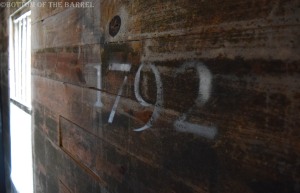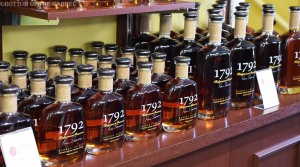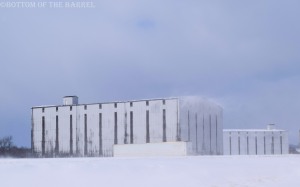Our first stop on the Bourbon Classic Media Camp tour was the Barton 1792 Distillery. It, like many present day distilleries, has an interesting history complete with several ownership changes, expansions, and setbacks. Nestled in the heart of Bourbon Country, Bardstown, KY, they currently produce several brands of bourbon including Very Old Barton and Kentucky Tavern (both of which have bonded versions available–UPDATE: KTBIB hasn’t been produced in about 6 years, the distributor stocks are gone, and apparently we have the last remaining bottles on Earth [knowledge gained ~4-15, updated 10-15…]), as well as their flagship 1792 Ridgemont Reserve which is named for the year Kentucky gained statehood.
The Basic Facts:
Parent Company: Sazerac Company, Inc. (New Orleans, LA)
Location: Bardstown, KY
Master Distiller(s): Ken Pierce
Mash Bill(s): Four different mash bills with undisclosed ratios
Aging Rickhouses: On site
Website: http://www.1792bourbon.com/
Public Tours: Yes, daily, and still free as of this writing
Highlights of the Tour and Grounds:
- All of the corn comes from within a 100 mile radius of the distillery, and they use 30 acres of corn everyday
- The rye and barley grains are sourced from several states, including further north, as the barley grows better there
- They operate one coal and two natural gas burners–the coal burner produces more than twice the steam as both of the gas burners combined
- They maintain thirteen mash tanks which hold 650,000 gallons of fermenting grains
- They operate a single 5 story column still called the “Ridgemont still,” and it’s a monster!
- The distillate comes off the still at 140 proof
- 28 traditional rick houses hold 19,600 barrels each, and the barrels are sourced from Independent Stave Company
- A newer pallet style warehouse holds 76,000 barrels, and that is just as enormous as it sounds (see photographs below)
- 1792 Ridgemont Reserve is a blend of 8-10 year old bourbons and it was first introduced in 2002
- Eight bourbons are produced on premises from 4 undisclosed mash bills
During the tour we were fortunate enough to thief directly from a ‘sweetheart’ 1792 barrel (barreled on 2-14-2006). This experience would have been cool enough on its own, but we may or may not have been able to take some pints of it with us on the bus. The tasting offered at the conclusion of the tour had their white dog, Very Old Barton, 1792, chocolate bourbon ball cream liqueur and, wait for it, another version of barrel strength 1792. We’re here to tell you that if the barrel strength never hits the market, it will be a crime against humanity. Take everything we love about regular 1792 and then amplify it into another stratosphere. The higher proof bumps up the barrel flavors but still maintains a great balance. Having talked with Ken Pierce and representatives from the distillery, they all staunchly maintain that they have no plans for a barrel proof release; however, they get this awkwardly frustrated look on their face when asked that screams, “please stop asking, we’ll tell you it’s coming out once the higher-ups say we’re allowed to!” Until then, we’ll just have to cross our fingers and hope.
A Brief History of the Barton 1792 Distillery
Ben F. Mattingly, whose grandfather had been a distiller in Louisville, KY, likely had no idea what he was ostensibly starting when he married Catherine Willett, of the family which owned Willett and Frenke. They operated a distillery at Morton’s Spring in Nelson County, Kentucky, just outside of Bardstown. In 1874, Mattingly and a Thomas S. Moore (who had also married into the Willett family) began working at Morton’s Spring Distillery. Two years later, ownership was transferred to themselves. All of this was occurring at what was the dawn of the Golden Age of Bourbon in the post war United States. Then, in 1881, around the time when their first barrels were coming of age, Mattingly sold the company to some investors and Thomas Moore continued to work there until 1899, when he then bought 116 acres next to Morton’s Spring to build his own distillery. A little over 15 years later, Morton’s Spring went out of business, and in 1916 Moore purchased it and incorporated it into his own distillery. Sadly, the next big event in this story is the passage of the 18th Amendment and the start of Prohibition. The distillery was forced to close as it did not get a license to distill medicinal alcohol.
After repeal, the distillery would reopen with Con Moore (Thomas Moore’s son) in charge. It was later sold to Oscar Getz, a Chicago liquor merchant who would later provide the foundation for the the Getz Museum of Whisky History in 1944. Getz is responsible for picking the name “Barton” at random, and the new Barton Distillery would go on to buy Glenmore Distillery in Owensboro, KY. Following ownership by Constellation Brands (who owned the US rights to Corona sales as well as prominent brandy brands such as Paul Masson), Sazerac eventually purchased Barton in 2009 for $334 million along with the bottling facility in Owensboro. At the time of the sale, Barton Distilling was actually the larger company, and Sazerac more than doubled in size overnight.
Popular Brands currently produced by Barton 1792 Distillery:
- 1792 Ridgemont Reserve, Very Old Barton, Kentucky Tavern, Tom Moore, Ten High, Colonel Lee, and (likely) Walking Stick Single Barrel.
- They also produce a number of other spirits, including varieties of vodka, brandy, and schnapps.
Cheerss, from Chris and Darren!



















(Some supplemental information via http://www.ellenjaye.com/barton.htm)
